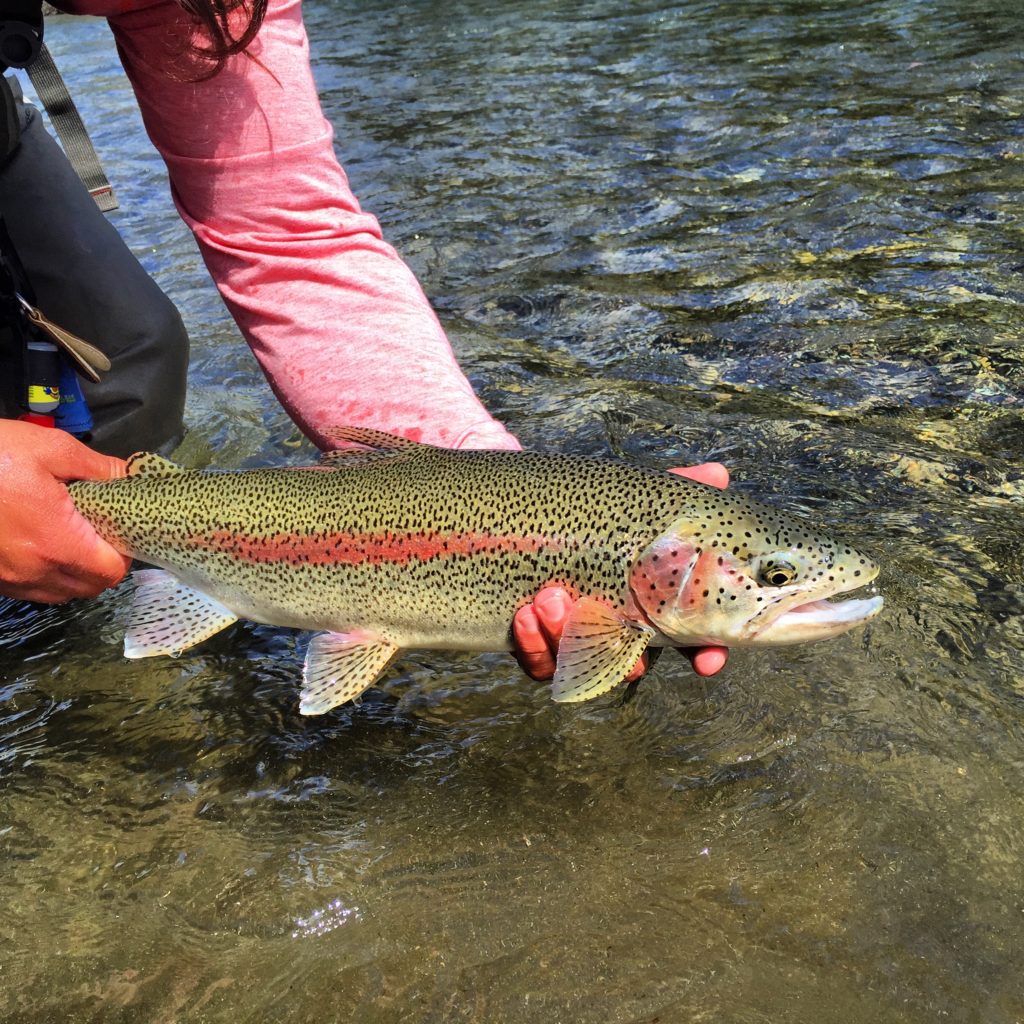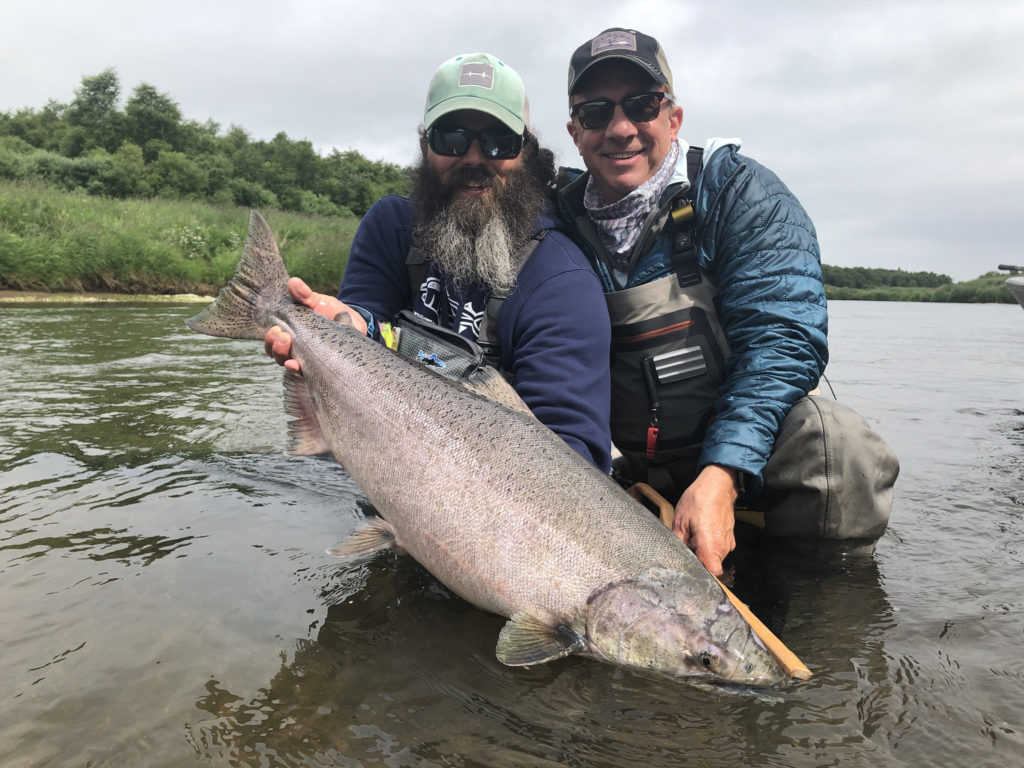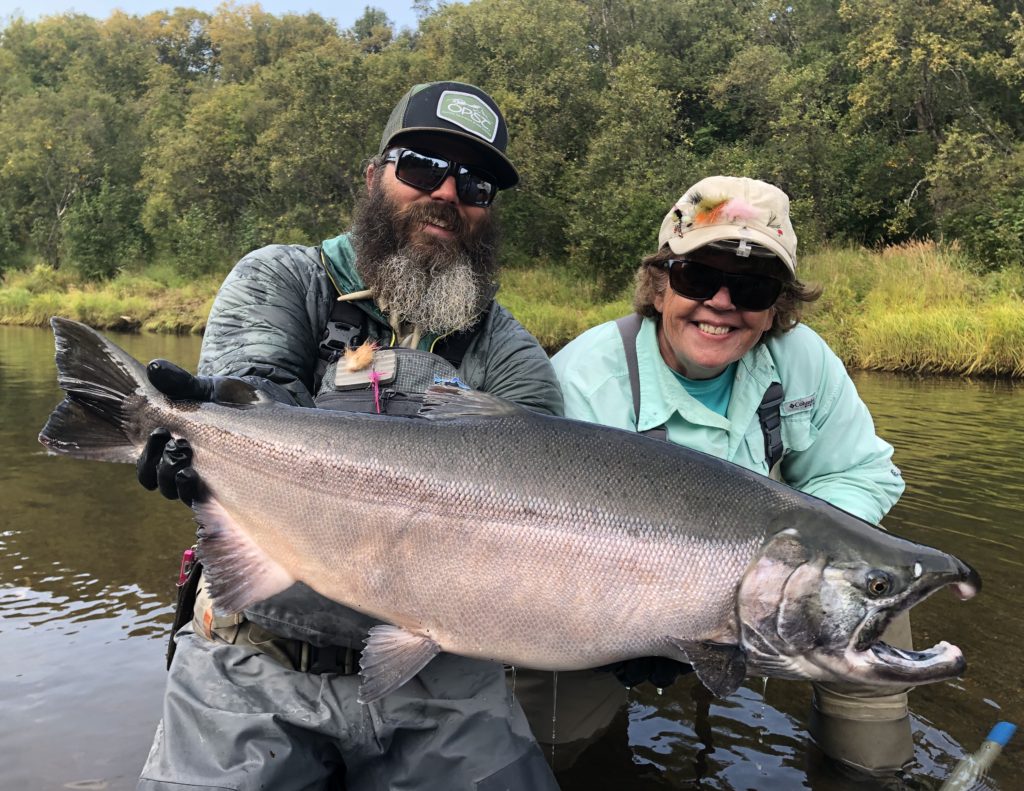Early Season – June & July
Smolting Rainbows on the Naknek:
5 or 6 weight fly rod with floating line for small streams. Small streamers like wooly bugger and minnow patterns, dry flies, and mice. Bring 2x, 3x, and 4x as well. If you plan on flying out you will need a pack or backpack to carry your gear and lunch.
8 weight with floating line for main river Rainbows, and shooting line or zip line for sockeye. If you would like to bring a sink tip for streamers bring it but make sure you have a floating line first.
The best rainbow fishing is close to camp. The rainbows concentrate on salmon smolt and leeches migrating downstream to the ocean. The best offerings include large rabbit strip and marabou leeches in black, olive and dark brown. NOT egg sucking leeches. Minnow imitations are also deadly in small to medium sizes.

Rainbows at Brooks:
Brooks is flies only. In June, July and early August, rainbows will eagerly take mice, dead drifted small dries, sculpins and leeches.
Recommended Tackle:
an 8 ½ to 10 foot fly rod for a 5-6 weight line. The WF floater is the most popular choice, although sink-tips (130 grain to 200 grain) will work as well. 3x to 5x tippets.
Grayling at Idavain:
This fishing starts out with a 1 mile hike to the better fishing grounds. Grayling are best fished with light tackle. I would use a 4 or 5 weight fly rod with a floating line. #12 and #14 adams, caddis and stoneflies (dry), small beadhead nymphs, leeches, woolybuggers and deer hair mice will all work here.

Kings:
These begin showing up mid-June, building throughout the month. Most of the fishing is down in the lower Naknek, where tide is important and the water is deep. Treble hooks are legal. By late July, they will begin moving into the rapids to prepare for spawning. Single Hook Only.
Recommended Tackle:
We have a lot of heavy rods and reels – spinning, revolving spool and fly – that guests can use.
If you want to bring some, I would recommend a 7 foot spinning rod with 30 pound braid for casting, a 9 foot spinning or casting rod with 30 pound braid for back-trolling and a 9’ for a 10 or 11 weight for flyfishing. The fly reel should employ a 400 – 600 grain sink tip line.
Large streamers in bright colors with lots of action work very well (salmon snakes, rabbit leeches, popsicles, etc.) Plugs are very popular locally, with large Kwikfish being #1, followed closely by Wiggle Warts and Hot-N-Tots in Chart, Fire Tiger, Hot Pink, silver/green and Orange. Large spinners are especially deadly, with blades in sizes 5 – 8 in silver, pink, chart and orange.
Sockeye:
Chrome sockeye begin their trip from the ocean around June 20th. This migration continues until late July (timing varies, of course, depending on weather). Until the spawn in mid- August, sockeye will hold in slow pools and side channels. They are usually turning red by early August.
Recommended Tackle:
A 6-8 weight fly rod in 9’ to 11’ lengths with a Climax Zip Line is by far the best choice. A floating line with either a strike indicator or a few split shot will also work well.
Other equipment needed or recommended:
Split shot in sizes b, bb and 3/0. Cone sinkers in 1/64th, 1/32nd, 1/16th, tapered leaders in 0x and 3x, fluorocarbon tippet in 2x – 5x, strike indicators in both 1 inch foam and yarn style, #12 black barrel swivels, forceps, nippers, floatant, brown or amber polarized sunglasses with strap, hat with brim, rain jacket, chest waders, wading belt, some like a wading staff, fleece pants, fleece sweater(s), wool socks, windproof fleece fingerless gloves, headnet, insect repellant, sun screen.
REMINDER- felt soles are illegal in all of Alaska!
Please make sure you have rubber soled wading boots.
Recommended Tackle:
A 6-8 weight fly rod in 9 ½ to 11 ½ lengths with a Climax Zip Line is by far the best choice. A floating line with either a strike indicator or a few split shot will also work well. Small nymphs and streamers work well as do small beads.
Late Season – August & September
Rainbows on the Naknek:
The best rainbow fishing is close to camp and in the rapids. The rainbows will still take salmon smolt and leeches migrating downstream to the ocean, but by far the biggest food source is salmon eggs. Sockeye eggs are 6mm, silvers and pinks are 8mm and kings are 10mm. Sometimes, oversize imitations work better. I like trout beads mottled beads in orange, dark roe and pinks in sizes 6mm – 12mm. Don’t forget #8 and #10 short shank hooks and toothpicks (or the clear plastic pegs). For leeches, I like articulated and bunny strip versions without eggs in front in black, olive, purple and flesh colors. Wool head sculpin also work well. Late in the season, flesh flies might be needed.
Recommended Tackle:
a light spinning rod in the 9 ½ – 11 ½ range, loaded with 4 – 8 pounds mono a 9 ½ to 11 ½ fly rod in the 6 to 8 wt range. I would want to have a 200 or 300 grain sink tip, a WF floating line and a Climax Zip line (or equivalent shooting line). 2x – 4 x fluorocarbon tippets.
a centerpin rig can be deadly for this fishing.
Rainbows at Brooks:
Brooks is flies only. In early August, rainbows will eagerly take mice, dead drifted small dries, sculpins and leeches. By mid to late August, the sockeye spawning kicks in and 6mm – 8mm plastic beads are king.
Recommended Tackle:
an 8 ½ to 10 foot fly rod for a 5-6 weight line. The WF floater is the most popular choice. I also love the zip line for this fishing. 3x to 5x tippets.
Margot Creek:
This is some of the best arctic char/ dolly varden fishing around, along with a decent population of rainbows. The stream is full of sockeye spawning by mid August., so beads are at great bet here, with or without a fly following behind. All the same patterns listed for Brooks work well here as well. If the water is discolored, 10 and 12mm beads are deadly. The rest of the time, 6mm and 8mm work best.

Silvers:
By early August, silvers should be running into the Naknek on each high tide. Bright marabou streamers in purples and pinks and other bright colors, spinners in sizes 3-5 in pink, orange, chartreuse, and silver all work very well at times, as do wiggle warts in the same colors. Lots of local guides prefer jigs in 1/8 and 1/16 ounce in pink and purple, fished with or without an indicator. When they get spooky, however, nothing compares to a shooting line, a very small split shot or 2 and a small marabou streamer (like a woolybugger or PM Wiggler) in black, purple, pink, olive and cream, fished on 2x-3x fluoro.
The best rods are 9 ½-10 ½ for a 7wt or 8wt. Line. I would want to have a shooting line, a floater and, possibly, a 200 to 300 grain sinking tip. For spinning, a 7 ½ med light rod, a reel with a smooth drag and 8 – 12 pound test line is best.
Pinks:
Every even year is a pink year on the Naknek, which means that 2012 will likely bring another strong run starting in July and continuing into mid-August. They are extremely aggressive, hitting all of the flies and lures listed for silvers, and then some. Small silver spoons and spinners work very well also.
They are in the 3 to 6 pound range, and so can be a lot of fun on a little lighter tackle. Light spinning rods with 8 pound line or fly rods in the 5-7 weight range are perfect. Same lines as silvers.
Kings:
Early in August, the kings begin moving to their spawning areas, either up the feeder streams or in the rapids of the main stream. King season closes at the end of July, but many will be hooked throughout most of August. They must be immediately released, of course. Most of the spawning area is single hook only. Large streamers, small marabou streamers and large eggs all work well.
Recommended Tackle:
We have a lot of heavy rods and reels – spinning and fly – that guests can use. If you want to bring some, I would recommend a 7-9 foot spinning rod with 30 pound braid for casting and a 9 ½ for a 9 or 10 weight for flyfishing. The fly reel should employ either a 400 – 600 grain sink tip line, a floating line with a strike indicator, or a Climax Zip line (or other suitable shooting line).
Sockeye:
Reds are thick in August and most of September. They are either spawning, or holding in slower seams waiting to spawn. The river and creek mouths around Naknek Lake will also be full of them.
Other equipment needed or recommended:
Split shot in sizes b, bb and 3/0. Cone sinkers in 1/64th, 1/32nd, 1/16th, tapered leaders in 0x and 3x, fluorocarbon tippet in 2x – 5x, strike indicators in both 1 inch foam and yarn style, #12 black barrel swivels, forceps, nippers, floatant, brown or amber polarized sunglasses with strap, hat with brim, rain jacket, chest waders, wading belt, some like a wading staff, fleece pants, fleece sweater(s), wool socks, windproof fleece fingerless gloves, headnet, insect repellant, sun screen.
REMINDER- felt soles are illegal in all of Alaska!
Please make sure you have rubber soled wading boots.